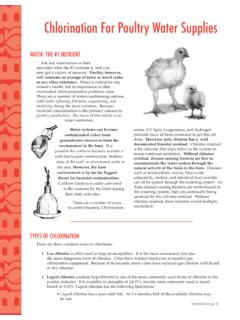Transcription of SAFETY DATA SHEET QUINTET CHLORINE SANITIZER
1 SAFETY data SHEET QUINTET CHLORINE SANITIZER 900043-120 1 / 9 SECTION 1. PRODUCT AND COMPANY IDENTIFICATION Product name : QUINTET CHLORINE SANITIZER Other means of identification : Not applicable Recommended use : SANITIZER Restrictions on use : Reserved for industrial and professional use. Product dilution information : No dilution information provided. Company : PureForce 370 N. Wabasha Street St. Paul, Minnesota USA 55102 1-866-444-7450 Emergency telephone : 1-800-328-0026 (US/Canada), 1-651-222-5352 (outside US) Issuing date : 10/24/2014 SECTION 2. HAZARDS IDENTIFICATION GHS Classification Oxidizing liquids : Category 2 Skin corrosion : Category 1A Serious eye damage : Category 1 GHS Label element Hazard pictograms : Signal Word : Danger Hazard Statements : May intensify fire; oxidizer.
2 Causes severe skin burns and eye damage. Precautionary Statements : Prevention: Keep away from heat. Keep/Store away from clothing/ combustible materials. Take any precaution to avoid mixing with combustibles. Wash skin thoroughly after handling. Wear protective gloves/ protective clothing/ eye protection/ face protection. Mixing this product with acid or ammonia releases CHLORINE gas. Response: IF SWALLOWED: Rinse mouth. Do NOT induce vomiting. IF ON SKIN (or hair): Remove/ Take off immediately all contaminated clothing. Rinse skin with water/ shower. IF INHALED: Remove victim to fresh air and keep at rest in a position comfortable for breathing.
3 IF IN EYES: Rinse cautiously with water for several minutes. Remove contact lenses, if present and easy to do. Continue rinsing. Immediately call a POISON CENTER or doctor/ physician. Wash contaminated clothing before reuse. In case of fire: Use dry sand, dry chemical or alcohol-resistant foam for extinction. Storage: Store locked up. SAFETY data SHEET QUINTET CHLORINE SANITIZER 900043-120 2 / 9 Disposal: Dispose of contents/ container to an approved waste disposal plant. Other hazards : None known. SECTION 3. COMPOSITION/INFORMATION ON INGREDIENTS Pure substance/mixture : Mixture Chemical Name CAS-No.
4 Concentration (%) sodium hypochlorite 7681-52-9 SECTION 4. FIRST AID MEASURES In case of eye contact : Rinse immediately with plenty of water, also under the eyelids, for at least 15 minutes. Remove contact lenses, if present and easy to do. Continue rinsing. Get medical attention immediately. In case of skin contact : Wash off immediately with plenty of water for at least 15 minutes. Use a mild soap if available. Wash clothing before reuse. Thoroughly clean shoes before reuse. Get medical attention immediately. If swallowed : Rinse mouth with water. Do NOT induce vomiting. Never give anything by mouth to an unconscious person.
5 Get medical attention immediately. If inhaled : Remove to fresh air. Treat symptomatically. Get medical attention if symptoms occur. Protection of first-aiders : If potential for exposure exists refer to Section 8 for specific personal protective equipment. Notes to physician : Treat symptomatically. See toxicological information (Section 11) SECTION 5. FIRE-FIGHTING MEASURES Suitable extinguishing media : Use extinguishing measures that are appropriate to local circumstances and the surrounding environment. Unsuitable extinguishing media : None known. Specific hazards during fire fighting : Oxidizer.
6 Contact with other material may cause fire. Hazardous combustion products : Decomposition products may include the following materials: Carbon oxides Nitrogen oxides (NOx) Sulfur oxides Oxides of phosphorus Special protective equipment for fire-fighters : Use personal protective equipment. Specific extinguishing methods : Fire residues and contaminated fire extinguishing water must be disposed of in accordance with local regulations. In the event of fire and/or explosion do not breathe fumes. SAFETY data SHEET QUINTET CHLORINE SANITIZER 900043-120 3 / 9 SECTION 6. ACCIDENTAL RELEASE MEASURES Personal precautions, protective equipment and emergency procedures : Ensure adequate ventilation.
7 Keep people away from and upwind of spill/leak. Avoid inhalation, ingestion and contact with skin and eyes. When workers are facing concentrations above the exposure limit they must use appropriate certified respirators. Ensure clean-up is conducted by trained personnel only. Refer to protective measures listed in sections 7 and 8. Environmental precautions : Do not allow contact with soil, surface or ground water. Methods and materials for containment and cleaning up : Stop leak if safe to do so. Contain spillage, and then collect with non-combustible absorbent material, ( sand, earth, diatomaceous earth, vermiculite) and place in container for disposal according to local / national regulations (see section 13).
8 Flush away traces with water. For large spills, dike spilled material or otherwise contain material to ensure runoff does not reach a waterway. SECTION 7. HANDLING AND STORAGE Advice on safe handling : Do not ingest. Do not get in eyes, on skin, or on clothing. Do not breathe dust/ fume/ gas/ mist/ vapors/ spray. Use only with adequate ventilation. Wash hands thoroughly after handling. Mixing this product with acid or ammonia releases CHLORINE gas. Conditions for safe storage : Keep in a cool, well-ventilated place. Do not store near acids. Keep away from reducing agents. Keep away from combustible material.
9 Keep out of reach of children. Keep container tightly closed. Store in suitable labeled containers. SECTION 8. EXPOSURE CONTROLS/PERSONAL PROTECTION Ingredients with workplace control parameters Ingredients CAS-No. Form of exposure Permissible concentration Basis sodium hypochlorite 7681-52-9 STEL 2 mg/m3 WEEL CHLORINE 7782-50-5 TWA ppm ACGIH STEL 1 ppm ACGIH Ceiling ppm mg/m3 NIOSH REL C 1 ppm 3 mg/m3 OSHA Z1 sodium hypochlorite 7681-52-9 STEL 2 mg/m3 WEEL CHLORINE 7782-50-5 TWA ppm ACGIH STEL 1 ppm ACGIH Ceiling ppm mg/m3 NIOSH REL C 1 ppm 3 mg/m3 OSHA Z1 sodium hypochlorite 7681-52-9 STEL 2 mg/m3 WEEL Engineering measures : Effective exhaust ventilation system.
10 Maintain air concentrations below occupational exposure standards. SAFETY data SHEET QUINTET CHLORINE SANITIZER 900043-120 4 / 9 Personal protective equipment Eye protection : SAFETY goggles Face-shield Hand protection : Wear the following personal protective equipment: Standard glove type. Gloves should be discarded and replaced if there is any indication of degradation or chemical breakthrough. Skin protection : Personal protective equipment comprising: suitable protective gloves, SAFETY goggles and protective clothing Respiratory protection : When workers are facing concentrations above the exposure limit they must use appropriate certified respirators.





